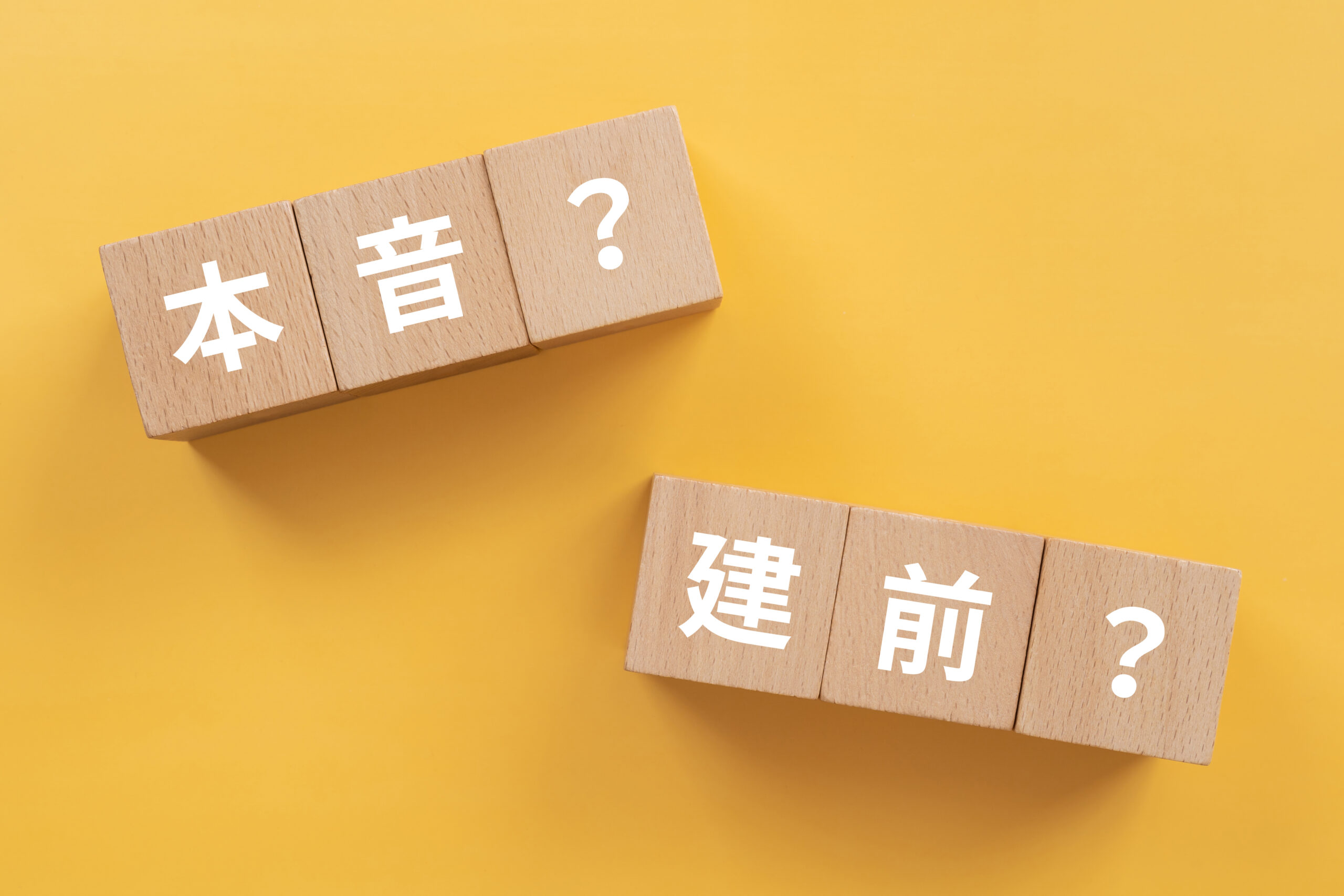Social Harmony in Japan: How Honne and Tatemae Shape Everyday Japanese Communication

“Why do Japanese people often say ‘yes’ even when they mean ‘no’? I want to understand what they really think, but I don’t want to be rude or misinterpret the situation.” You may have felt this confusion too.
Understanding honne (true feelings) and tatemae (public facade) is key to navigating communication in Japan. These cultural concepts shape how people interact, build relationships, and maintain social harmony. Recognizing the difference can help you avoid misunderstandings, whether at work, in daily life, or in friendships.
In this article, we’ll explore the deep cultural roots of honne and tatemae, how they function in modern Japanese society, and how you can read between the lines to communicate more effectively and respectfully in Japan.
What Are Honne and Tatemae?
The Definitions: What Do Honne and Tatemae Really Mean?
Honne and tatemae are fundamental cultural concepts in Japan that explain the distinction between a person’s true feelings and the public facade they present to others. Honne (本音) refers to one’s genuine thoughts and feelings, the inner truth that may not be immediately shared in social interactions. On the other hand, tatemae (建前) refers to the public behavior or the social mask that one wears to maintain harmony and avoid conflict.
In Japanese culture, communication is often indirect, with a strong focus on the group and social unity. Therefore, these concepts help to navigate the complexities of daily interactions, where maintaining harmony is prioritized over direct expression of individual desires. Honne reflects personal truth, while tatemae reflects what is socially appropriate in a given context.
Origin of the Terms in Japanese Culture
The concepts of honne (本音) and tatemae (建前) have deep roots in Japan’s long-standing cultural values, including influences from Confucianism (儒教, jukyō). Introduced from China, Confucianism emphasized social harmony, hierarchy, and proper behavior—principles that became important in Japanese society over centuries. These values encouraged people to prioritize group needs over personal feelings, leading to a communication style where individual expression is often carefully managed. Over time, honne and tatemae developed as key ways to balance true emotions with the expectations of society, helping to maintain social harmony (和, wa) in daily life.
The Contrast Between Inner Feelings and Social Expectations
One of the central aspects of honne and tatemae is the contrast between what a person truly feels and what they are expected to express in social settings. In many situations, especially in public or work environments, it is not uncommon for people to suppress their true feelings (honne) to avoid disturbing the social harmony. For example, a person might say “yes” to a request they do not agree with, simply to maintain peace and avoid conflict, even though their inner feeling might be negative or resistant.
The Role of Honne and Tatemae in Japanese Communication
Everyday Examples in Conversations
The use of honne and tatemae is seen frequently in everyday conversations in Japan, where indirect communication is the norm. In many cases, Japanese people will choose to express themselves in ways that do not directly reveal their true thoughts, especially if those thoughts might disrupt harmony.
Saying “Yes” When You Mean “No”: Why It Happens
A classic example of this is when a person says “yes” or agrees to something, but their true feelings (honne) may suggest otherwise. This occurs to avoid confrontation or to adhere to social expectations. In Japanese society, it is often seen as impolite to refuse a request directly, even if the person does not actually intend to follow through. In these cases, the response may be a form of tatemae, where the speaker says “yes” but does not intend to act on it.
The Subtleties in Tone, Silence, and Body Language
Often, Japanese people will use subtle cues, such as tone of voice, silence, or body language, to indicate their true feelings without explicitly saying them. This reflects the high-context nature of Japanese communication, where much is left unsaid, and understanding relies on shared cultural knowledge. For example, a slight hesitation in the tone or a non-committal gesture can signal discomfort or disagreement, even though the words spoken may suggest otherwise.
How Indirect Communication Builds Harmony
Tatemae is central to maintaining social harmony in Japanese culture. When individuals prioritize the group’s well-being over personal expression, they help prevent conflict and foster a cooperative environment.
The Unspoken Rules of Politeness
In Japan, politeness is expressed not only through words but also through behavior, attitudes, and a shared understanding of unspoken rules. People communicate with careful attention to how their words and actions might affect others. Tatemae allows individuals to maintain social order and protect group harmony without causing discomfort. For example, polite phrases and formal expressions are often used as a social custom, even when the speaker is not personally invested in the message they are delivering.
Reading Between the Lines in a High-Context Culture
In a high-context culture like Japan, much of the meaning in communication is conveyed indirectly, through context, tone, and body language, rather than through explicit words. Therefore, understanding the hidden messages or the unsaid thoughts (honne) requires careful attention to the cultural context. This is a crucial skill for anyone living or working in Japan, as misinterpretation of these subtle cues can lead to misunderstandings.
Why Honne and Tatemae Are Essential for Social Harmony in Japan

Avoiding Conflict Through Social Facades
How Tatemae Protects Group Cohesion
In Japanese culture, tatemae (建前)—the outward expression of socially appropriate behavior—plays a crucial role in maintaining group harmony (和, wa). By aligning one’s public demeanor with collective expectations, individuals help ensure smooth interactions and avoid potential conflicts. This practice supports the cultural emphasis on consensus and mutual respect, fostering a cohesive social environment.
While this approach may sometimes require individuals to withhold personal opinions, it reflects a shared commitment to preserving harmony within the group. Through tatemae, Japanese society maintains a sense of unity and cooperation, essential for the functioning of various social settings.
Honne as a Private Space for Trust and Intimacy
In Japanese culture, honne (本音)—a person’s genuine thoughts and feelings—is typically shared only within close relationships. Expressing one’s honne requires a foundation of trust and is often reserved for family members or intimate friends. This practice allows individuals to maintain personal authenticity while adhering to social expectations in public settings. By keeping honne private, people can navigate social interactions smoothly, preserving harmony while still having a space for honest expression.
Group First, Individual Second: The Cultural Logic
The Influence of Confucian Values
Japanese social structures have been shaped by various influences, including Confucian principles that emphasize hierarchy, respect, and the importance of the collective over the individual. These values have contributed to communication styles that prioritize group needs, encouraging individuals to sometimes withhold personal opinions to maintain group consensus.
Role of Group Identity in Communication
In Japanese culture, the concept of uchi-soto (内-外)—meaning “inside” and “outside”—plays a significant role in shaping communication. People tend to express their honne (本音, true feelings) more openly within their uchi (内, inner circle), such as family and close friends. Conversely, when interacting with those considered soto (外, outsiders), they often adopt tatemae (建前, public facade) to align with social expectations and maintain harmony. This distinction influences language use, behavior, and the level of formality in various social contexts. Understanding this dynamic is key to navigating interpersonal relationships in Japan.
How Honne and Tatemae Influence Workplace Culture and Daily Life

Business Etiquette and Decision-Making
Why Silence Doesn’t Mean Agreement
In Japanese business settings, silence often plays a significant role in communication. Rather than indicating agreement, silence can signify contemplation or a polite way to avoid direct confrontation. This practice aligns with the concept of tatemae (建前), where individuals prioritize group harmony over personal opinions. Understanding that silence may not equate to consent is crucial for effective communication in Japanese workplaces.
Nemawashi and Behind-the-Scenes Consensus
The process of nemawashi (根回し) involves informal discussions and consensus-building before formal meetings or decisions. This behind-the-scenes approach allows for the expression of honne (本音)—true feelings—in a private setting, ensuring that all parties are aligned before public announcements. Nemawashi exemplifies the balance between honne and tatemae, facilitating smooth decision-making while maintaining group cohesion.
For Further Reading:

Family and Friendship Dynamics
How Honne Is Expressed in Trusted Relationships
In Japanese culture, honne (本音)—one’s true feelings and desires—is typically reserved for close, trusted relationships. Expressing honne requires a foundation of trust and is often limited to family members or intimate friends. This distinction allows individuals to maintain personal authenticity while upholding social expectations in public settings. Over time, as relationships deepen, individuals may feel more comfortable sharing their honne, fostering stronger bonds and mutual understanding. This balance between private sincerity and public decorum is a key aspect of interpersonal dynamics in Japan.
Maintaining Harmony at Home Through Tatemae
Even within families, the practice of tatemae (建前)—presenting a socially appropriate front—plays a role in preserving harmony. Family members might choose to withhold certain opinions or feelings to avoid conflict, reflecting the broader cultural emphasis on group cohesion. This approach is rooted in the Japanese cultural value of wa (和), which prioritizes harmony and smooth relationships. By navigating interactions with consideration and restraint, family members contribute to a peaceful and supportive home environment.
As Japan becomes more interconnected with the global community, the traditional concepts of honne and tatemae are slowly evolving, especially in business settings. While these cultural norms have historically played a key role in maintaining social harmony, international influences are encouraging more open and direct communication. However, it’s important to remember that how honne and tatemae are expressed can still vary widely depending on the individual, the context, and the specific relationship. In business, there’s a growing trend towards more transparency and assertiveness, but the balance between maintaining respect for others and expressing true feelings remains a delicate art, often shaped by personal personality and the culture of the organization.
Understanding Honne and Tatemae as Part of a High-Context Culture
What Is a High-Context Culture?
A high-context culture refers to a society where people rely on non-verbal communication, shared knowledge, and the context of the situation to understand messages. In such cultures, much of the communication is indirect, and the meaning is often implied rather than explicitly stated. Honne and tatemae are a perfect example of this, as much of the communication in Japan is based on context, relationships, and unspoken social rules rather than just the words spoken.
Comparison with Low-Context Cultures like the U.S.
In contrast, low-context cultures, like the U.S., value direct and clear communication. People are expected to express their thoughts and feelings openly, with less reliance on context or the social background. In a low-context culture, saying exactly what you mean is often seen as more honest and efficient, while in high-context cultures like Japan, understanding the deeper meaning often requires knowledge of the relationship, the setting, and the person’s intentions.
Role of Shared Understanding and Social Cues
In high-context cultures like Japan, a lot of communication is about reading between the lines and understanding social cues. This shared understanding allows people to communicate effectively without always saying everything directly. Honne (true feelings) and tatemae (public facade) help navigate these unspoken social rules, where the context and the relationship determine what is said and how it is understood.
How Japan’s Communication Differs from Other Countries
Cultural Norms That Shape Communication Styles
Japan’s communication style is shaped by cultural norms that emphasize harmony, respect, and group cohesion. These values are reflected in how people use honne and tatemae to manage relationships and navigate social expectations. While direct communication is valued in many Western cultures, Japan’s approach places importance on maintaining wa (harmony), and this affects everything from personal conversations to professional interactions.
Miscommunication Risks for Foreigners
For foreigners in Japan, understanding the balance between honne and tatemae can be challenging. The indirect nature of communication means that foreigners may not always pick up on subtle hints, and they might interpret tatemae (the polite, outward behavior) as insincerity. Misunderstandings can happen if the cultural context isn’t fully understood, which is why it’s important for foreigners to be sensitive to the social cues and context in which communication takes place.
How Foreigners Can Navigate Honne and Tatemae in Japan

Practical Tips for Living and Working in Japan
How to Respond to Indirect Feedback
In Japanese workplaces and social situations, feedback is often given in indirect ways, especially when the message might be sensitive or critical. Instead of saying “This is wrong,” someone might say, “Maybe we could consider another way.” This style is meant to avoid confrontation and maintain harmony (和, wa).
As a foreigner, it’s important to listen carefully not just to words, but also to tone and context. If feedback seems vague, it’s helpful to ask clarifying questions politely, such as:
“Would it be better if I try a different approach?”
This shows humility and respect for the group dynamic while helping you understand the real message.
When to Use Honne or Tatemae as a Foreigner
Foreigners are not always expected to use tatemae (建前) in the same way as native Japanese people, but understanding when it is appropriate can help avoid misunderstandings. In formal settings, such as business meetings or public events, it’s wise to lean toward tatemae-style communication—being polite, modest, and indirect.
However, in more personal or casual relationships, like with close friends or trusted coworkers, it becomes more acceptable to express your honne (本音)—your true thoughts and feelings. Over time, you will sense where this line lies, especially if you pay attention to how others interact in different contexts.
Building Trust Without Breaking Cultural Norms
Being Respectful While Staying Authentic
It can be difficult to balance being yourself with respecting a new culture, but it is possible. The key is adapting without pretending. Being overly direct may seem honest in your own culture, but in Japan, it can appear rude or insensitive. Try to express yourself clearly but gently, showing that you understand local values.
You don’t need to hide your personality—Japanese people often appreciate foreigners who show sincerity and kindness, even if their communication style is different. Being aware of how your words are received can help build mutual understanding.
Learning Through Observation and Humility
Much of Japanese communication is learned through observation. Watch how others speak in meetings, how they respond to feedback, or how they avoid direct disagreement. These subtle patterns reveal when tatemae is being used and how honne may emerge in more private moments.
Adopting a mindset of humility helps you build stronger relationships. Instead of trying to “master” Japanese communication quickly, try to learn by listening, asking questions, and reflecting on experiences. Over time, you will naturally find a rhythm that respects cultural norms while staying true to yourself.
In today’s globalized world, especially in international business settings, communication norms in Japan are also evolving. While honne and tatemae remain important, many workplaces are becoming more open to direct and diverse communication styles, especially when working with people from different cultures.
Misunderstandings and Challenges: When Honne and Tatemae Clash
Real-Life Scenarios of Cultural Misunderstandings
The Cost of Taking Words at Face Value
In Japan, people often choose words carefully to avoid conflict, even if it means not saying what they truly think. For foreigners used to direct communication, this can lead to misunderstandings. For example, a polite “maybe next time” might be a soft rejection, not an actual plan to meet again. Taking such words literally can create false expectations or confusion.
Navigating Conflict When Norms Are Not Shared
When different cultural expectations meet, like a Western direct style and Japan’s indirect approach, miscommunication can happen. A foreign colleague might see a lack of open disagreement as agreement, while the Japanese side may assume their hints were understood. These gaps can lead to frustration on both sides if not recognized and addressed with care.
Coping With Emotional Distance
When Tatemae Feels Cold or Insincere
For those unfamiliar with Japanese culture, tatemae may sometimes feel distant or even fake, especially when people avoid giving honest opinions. This emotional gap can make it hard to build trust at first. But in Japan, maintaining harmony is seen as a sign of respect, not dishonesty. Understanding this cultural logic can help foreigners interpret such behavior more accurately.
How Japanese People Manage Internal Dissonance
Balancing honne and tatemae can be emotionally tiring for Japanese people, too. They often rely on close friends or private settings to release their true thoughts and feelings. This contrast allows them to stay socially appropriate while still having emotional outlets—an important way to maintain both mental well-being and harmony in daily life.
While honne and tatemae can be complex, Japanese people generally appreciate honesty and sincerity more than perfect cultural understanding. As long as your intentions are respectful, minor misunderstandings are usually overlooked.

Conclusion: Embracing Nuance in Japanese Communication
Honne and tatemae show how Japanese people balance personal feelings with social expectations. These concepts help avoid conflict and keep relationships smooth. By learning about them, we can better understand Japanese culture and communicate with more care and respect. This awareness is useful not only in Japan but in any international setting, where understanding different ways of communication builds stronger connections.
Q&A About Honne and Tatemae
Is it okay to express honne openly in Japan?
Yes, but timing and trust matter. People usually share honne with close friends or family. In public or formal settings, too much honesty can feel disruptive or rude.
Why do Japanese people avoid direct answers?
This often comes from a desire to avoid hurting others or creating conflict. It’s a way to keep the atmosphere polite and cooperative.
How can I tell the difference between honne and tatemae?
It’s not always easy. Watch body language, tone, and context. Over time, you’ll notice patterns—like hesitation or vague wording—that suggest someone is using tatemae.
Are there situations where tatemae is inappropriate?
Yes. In personal relationships, relying too much on tatemae can create distance. Honest communication is needed to build trust over time.
What should I do if I feel confused by indirect communication?
Don’t panic. Stay calm, ask gentle follow-up questions, and observe how others react. Most Japanese people understand that foreigners may interpret things differently and appreciate sincere effort.
